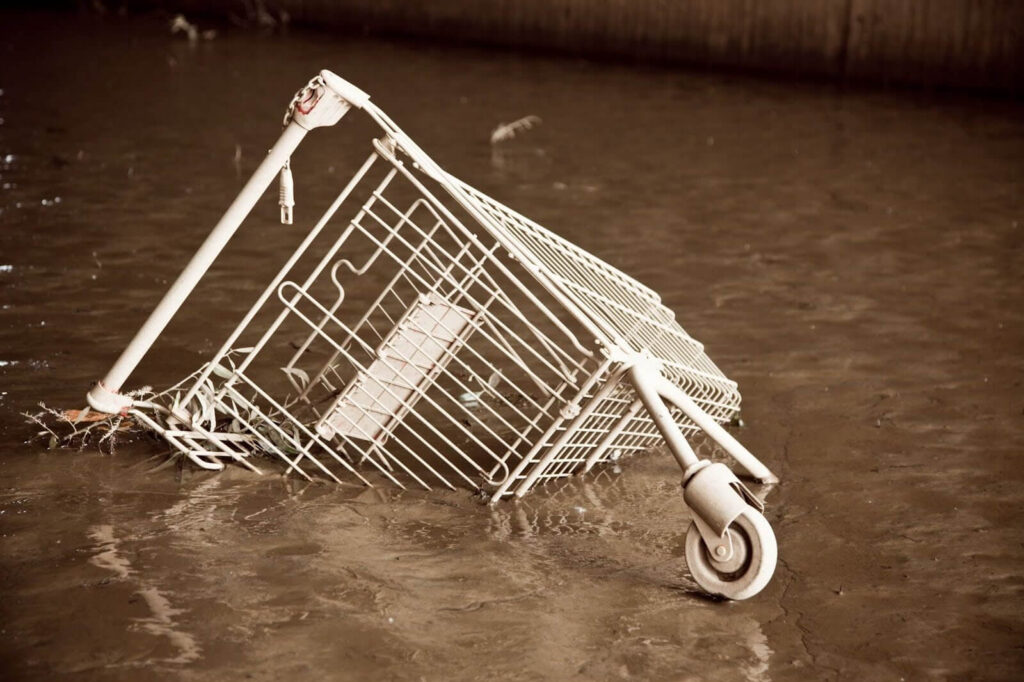Shopping carts and baskets are critical assets for retailers, playing a key role in the customer experience and overall store operations. However, frequent use, mishandling, and various environmental factors can lead to significant damage over time. Understanding the most common causes of cart and basket damage is essential for retailers who want to reduce repair costs, improve safety, and extend the lifespan of their equipment. Let’s explore some of the top causes of shopping cart damage and how retailers can mitigate these issues.
What Causes Shopping Cart Damage?
Cause 1: Overloading
The Problem
One of the most common causes of cart and basket damage is overloading. When customers or staff fill carts and baskets beyond their intended capacity, the excess weight can strain the wheels, handles, and frame, leading to structural issues and premature wear.
The Solution
To prevent overloading, educate staff and customers on proper usage limits and ensure that carts and baskets are clearly labeled with their maximum load capacities. Offering a range of cart and basket sizes can also help customers choose the appropriate option for their needs.
Cause 2: Rough Handling
The Problem
Rough handling, such as slamming carts into walls, forcing them over curbs, or dropping baskets, can result in broken wheels, bent frames, and cracked handles. These impacts significantly reduce the lifespan of the equipment and can create safety hazards for customers.
The Solution
As a retailer, you can mitigate rough handling by training staff to handle carts and baskets carefully and by placing clear signage around the store reminding customers to do the same. Assigning staff members to the ongoing tasks of regularly inspecting and fixing shopping carts can help identify any signs of damage early, allowing for prompt repairs.
Cause 3: Environmental Factors
The Problem
Exposure to environmental elements such as rain, snow, and extreme temperatures can cause carts and baskets to deteriorate over time. Metal components may rust, plastic parts can become brittle, and wheels may lose their smoothness, making the carts harder to use.
The Solution
You don’t want to have to buy a shopping cart every time it storms. So to protect against environmental damage, consider storing carts and baskets in covered areas when not in use. In addition, using rust-resistant materials and applying protective coatings can help extend the life of equipment exposed to harsh conditions.
Cause 4: Wear and Tear
The Problem
Even with the best care, everyday use of carts and baskets leads to normal wear and tear. Handles may loosen, wheels may wear down, and the overall structure can weaken after long-term use.
The Solution
Regular maintenance is key to managing wear and tear. Establishing a schedule for routine inspections and repairs can help retailers address minor issues before they become major problems. Replacing worn-out parts like wheels or handles as soon as they show signs of wear can keep carts and baskets in good working order.
Cause 5: Poor-Quality Materials
The Problem
Carts and baskets made from low-quality materials are more susceptible to damage, especially when used frequently. Inferior plastics can crack, and low-grade metal components may bend or rust quickly, leading to a shorter lifespan and higher replacement costs.
The Solution
How much do shopping carts cost? This all depends on the size, quantity, and materials in your carts. Needless to say, investing in high-quality carts and baskets made from durable materials is the best way to avoid frequent damage and costly repairs. Prioritize purchasing equipment from trusted manufacturers that guarantee durability and reliability (like Good L Corporation!).
Cause 6: Misuse
The Problem
Misuse of carts and baskets, such as using them for unintended purposes (e.g., transporting heavy or non-retail items) or riding in carts, can lead to significant damage. This can stress parts of the cart or basket that were not designed to withstand such strain.
The Solution
Clear communication with staff and customers about the proper use of carts and baskets is essential. Strongly consider posting visible signage that discourages misuse and provides adequate training to employees on how to use the equipment.
Cause 7: Improper Storage
The Problem
Improper storage of carts and baskets, such as stacking them incorrectly or leaving them in cluttered areas, can lead to physical damage. Improper nesting can bend frames or scratch surfaces, and insufficient space can cause carts and baskets to be mishandled during retrieval.
The Solution
Ensure carts and baskets are stored in designated areas where they can be neatly organized and easily accessed (such as cart corrals). Don’t forget to implement proper nesting procedures to avoid damage and reduce the risk of equipment getting knocked over or tangled up.
Don’t Leave Quality to Chance—Trust Good L Corp!
As we’ve seen, damage to shopping carts and baskets can be caused by a variety of factors. By understanding these common causes and implementing preventive strategies, you can extend the life of your equipment and maintain a better customer experience. Well-maintained carts and baskets not only reduce costs but also improve overall store efficiency and safety.
Wondering where you can buy a shopping cart? Look no further than Good L Corp! We produce durable, American-made carts and baskets to equip your retail establishment. If you’re ready to learn more, contact us today!


Request a Quote
Get a boost to your impulse sales which ultimately leads to an overall improvement of your total sales. Don’t you want to increase sales? Of course you do!